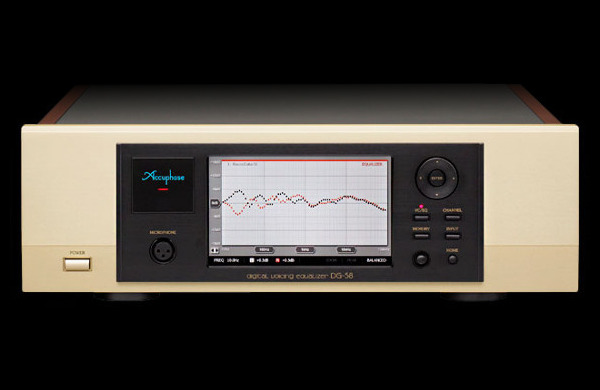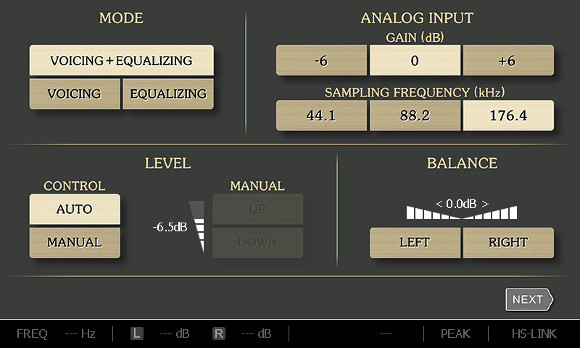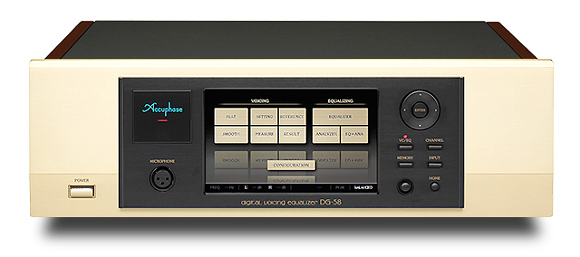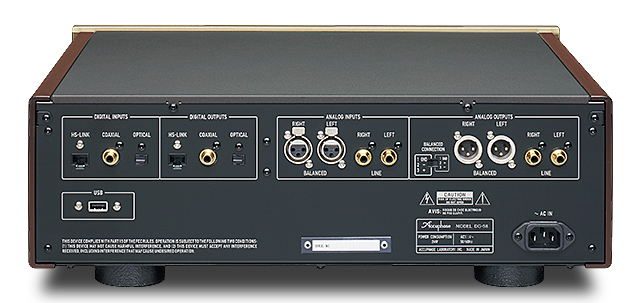ACCUPHASE DG-58
This review will not be centered about technical information too much. There is enough info at the Accuphase's global website and smartphones with online translators are efficient today. The goal of the DG-58's introduction is to explain the philosophy behind the device, to inspire the reader to explore the world of the voicing equalizer.

The Day The Things Have Changed
After one month of experimentation with this powerful ´voicing´ device I am ready to make following statements:
- Before I assumed that I had perfect sound at my home,
- Before I was considering purchasing another system for more aggressive music genres,
- Before I had firm (yet often incorrect) assumptions on how individual frequencies sculpt the sonic picture.
Well, this was the before status. So, what is after? In one sentence: there is no after without the Accuphase DG-58. I had four opportunities to flirt with digital sound processing to adjust acoustic parameters of my room. Never had I any urge to keep them in my system, until now..
The Past
In most instances it is better not to know what the acoustic response of your room looks like. What we perceive as the 'flat' sound usually exhibits many mountain high peaks and deep valleys and looks terrible. Let's say you did those measurements anyway - the next step is to flatten this ugly curve. The ideal way how to tackle it is to make acoustic adaptations in the listening room. This is not to say it is the cheapest way and some issues cannot be addressed by those adaptations at all. No matter if the room is big or small there will be waveform interactions that prevent the ideal result. In my experience the smaller rooms are easier to handle as the reverberation time is better controllable, yet they suffer from too much low frequency pressure. So, an effective acoustic treatment is very expensive and requires extensive knowledge. But we can work around with a DSP processors. In the dark past I had an experience with Technics's SH-8065 analog 33-band equalizer - it is not a DSP of course but it was nice to hear how the sound morphed when shuffling its sliders. The first real DSP I had on hand was Lyngdorf.
The Lyngdorf Roomperfect RP-1 is by far the simplest, fastes and the least expensive way of flattening the room response. It is connected in the analog path between a source component and an amplifier - or in the tape loop of the amp. Your task is to position the supplied microphone and let the device to scan your room. The Lyngdorf then automatically presets 7 voicing curves. The problem is that in practice max 2-3 curves are useful and one cannot modify them.
The Copland DRC 205 was the next in line. It advanced over the Lyngdorf with editable equalizing curves. Yet the possibilities of the device were outbalanced by non-audiophile grade converters and the fact that the signal could be routed only through analog single ended RCA cinches.
The most versatile device I loved was the professional mastering processor: Behringer DEQ2496 Ultracurve Pro. I reviewed it for Audiodrom a few years ago and can heartily recommend it. By spending some time with the DEQ2496 one can significantly enhance his knowledge about the sound in-room behavior; the downside is that the Behringer is not ready to make automated room corrections and you have to start with the set of your own measurements and adjust the bands one by one. Also its A/D and D/A conversion quality, though 24/96, is at the entry-level quality. In result it brings it signature to the frequency-optimized sound.
The McIntosh MEN220 happened to be my last but not least encounter with a room processor. The American legend chose the American way: they licensed the Roomperfect chips fom Lyngdorf and packed them in the McIntosh box. There is no benefit over the Roomperfect RP-1 apart from the design and that the price tag rose threefold. It is apparently for McIntosh's rock hard fans only.
The Accuphase DG-58 is the 4th generation 'voicing equalizer' of Japanese manufacturer. The device won me over with its craftmanship, top notch operation and friendly UI (based on Windows 7 platform). It comes in traditional satin gold with high gloss wood side panels. Most importantly, it changes the sound for better and it does so in a sophisticated way.
This is an example of the user interface screen:

Before I assumed that I had perfect sound at my home...
Well, by moving my house I could afford the luxury of a dedicated listening room, built from scratch. Then I spent next 3 years fine tuning the room with diffusion and absorption and the equipment to the state of subjective perfection. I arrived to the point of peace of mind with only one frequency excess at 30Hz and another at 510Hz - other than that the measured room response was within +/- 2,5dB at 1/6 octave, between 25Hz and 20kHz, with even 250ms waterfall from 120Hz up.
So, how does it come that the Accuphase DG-58's effect is so profound? The important fact to realize is that at 1/12 octave the granularity of results gets much bigger. On top of that, the peak at 30Hz that I mentioned would not be any worry if it did not 'overhung' in time - its resonant behaviour was overwriting other frequencies too.
The Accuphase provides two options to deal with the sound. You can use one or another, yet I highly recommend using them both in the order that is recommended by the manufacturer for the results are the best.
| VOICING |
The voicing is a routine similar to the Lyngdorf RoomPerfect's Focus mode. It is easy to perform it as Accuphase made an automated process for it - take the supplied microphone, position it at the level of your ears in the listening seat and press a button. The DG-58 generates series of warbled tones across the whole frequency spectrum and generates a desired response. Usually the first option is FLAT 10Hz-100kHz - who does not want to know what the sound of flat response sounds like? The Accuphase makes possible to set a tolerance range that says how strictly the device should adhere to no-compromise flatness. All actions are performed either through the touch display (of a tablet type) with stylus, or via remote. The example of the original and the corrected room response is in the picture below.

Another preset option enables a SMOOTH voicing - the routine respects the existing room imperfections and only corrects obvious peaks and dips of the smooth waveform. Finally, the advanced (or playful) listener can draw any reference curve that he likes and the DG-58 calibrates itself to it. The result of the above mentioned procedures is the 'voicing'. If you wish you can modify it at will with 0.5dB accuracy. The Accuphase has much more up in the sleeve, like response measurements of speakers or transducers, yet for the simplicity of this review I will stick to the most relevant applications.
The voicing (either the automated or the one you edit and adjust) will become something that your ears will immediately take as a new reference. Any final result or unfinished concept can be stored in one of the 30 device's memory slots. You can switch between the saved curves on the fly so it is actually quite easy to make decisions type of 'better/worse'. Should you need more memory spaces the DG-58 can export and import the correction files to and from an USB stick. At the end of the day, if you wish to correct every single album in your collection individually, you are welcome. The DG-58 performs the voicing operation separately for each channel so the speakers are perfectly synced and the music gains in focus and depth - see the picture below for before and after differences between channels.

In my case I saved three different voicings as references: the automated flat voicing, the fine tuned flat voicing with +/-0.5dB variations in the whole frequency range, and the 'smooth' voicing that respects the natural room sound. Whereas can I hardly note any difference between the flat and the superflat voicings, the difference between the flat and the smooth is easily identifiable. Once ready, the equalization awaits.
| EQUALIZING |
The DG-58's digital equalizer provides 80 (!) adjustable bands that can be manipulated within +/- 12dB. For my own set-up I used the DG-58 in the external DSP mode with the Accuphase DP-720 SACD player, thus avoiding the conversion to analogue signal and back, which I preferred to the DG-58 connected via its XLR connections in the analogue path between the player and the preamp or between the preamp and the power amp.
How does the equalization work?
Choose any of the saved voicings. I bet you choose the flat one which is the real reference but usually misses one important thing: the life. So, grab your favorite music selection and while listening to it feel free to modify, band by band, the sound until you hit the one you like. Again, you can use the stylus or the remote - I preferred the RC as I did not have to leave my sweet spot and had immediate feedback. To create smooth and more natural transitions the DG-58 can work with high Q of 19 bands to 'bell shape' the equalization curve. It is pity that the Q is not adjustable but with a bit of experimentation one can work around.
So now Pink Floyd (Diana Krall, Patricia Barber, Dire Straits, or any other obligatory audiophile stuff) is playing and you spend some time manipulating the EQ points. I used classical music tracks for the fine tuning of the voicing with the equalizer so I could not get too much naughty if I did not want to impair timbres and colors. Yet I could add a bit of air and spark above 12kHz, suppress 5-6kHz a bit for velvety sound and cut anything below 27Hz with steep filter. Why 27Hz? It is the lower working point of my Bowers Wilkins 802 Diamond and it helped to remove deep frequency rumble and helped the amp. Coincidentally the 27Hz is the low end of the grand piano so when I ended up with -3dB at 23Hz I assumed I had not miss anything except of organ music. Once ready, everything was saved in the memory of the Dg-58. Well, but how about my collection of heavy metal albums? And the electronic dance music I have? Japanese Kodo drummers? Solo piano recitals?

Before I was considering purchasing another system for more aggressive music genres...
If you have reached this point of the review you already know what is the Accuphase DG-58's strength - on top of the flattening and smoothing the frequency response in the listening room a listener can 'spoil' this response to his preferences, in many ways.
At the same time you can make your speakers produce sweet and relaxing sound and - by touch of a button - transform the sound into heavy metal pandemonium. Certain amount of maturity and transparency of the audio chain is a prerequisite. For example, if the speakers are sweet and relaxing sounding then this signature will cast the veil on any frequency manipulation. You can definitely improve such sound with the DG-58 but not alter it by 180°. The Accuphase DG-58 is the final touch to a balanced system, not a universal solution to all issues.
I admit that with aggressive heavy metal music I missed the proper edge and bite from my system. It was too much pristine, too much balanced, too much studio-like. The DG-58 arrived as a blessing. On top of that it was a great educational tool too. I spent hours and hours by moving the equalizing points up and down on the screen in search of the perfect sound. Not always the final effect - what you hear - is intuitive. I wanted the kick drum to be brutally punchy, for example. Means bass, right? So I started to manipulate with 30-80Hz area with no positive result. Yes, the weight of the drum rose and the music got much thicker but I lost clarity and the mix became muddy. To successfully fine tune the kick drum (and electric bass too) I had to touch 120Hz, 600Hz, 1kHz, 5kHz... It makes no sense to publish the equalization curves I saved for different types of music and my favorite albums - each of us has totally different listening environment and preferences. At the end of the day, this is how I utilize the Accuphase DG-58:
I am listening to Edelmann and Chopin's Ballads on Exton's Direct Cut - the sound is just beautiful, rich, sparkling and colourful. Another CD in the player, Anthrax's Persistence of Time, hell incarnated, guitar staccatos, pounding drums, soaring guitar solos, volume at max and everything sounds just right. Another CD in the player, Harry James and his swing on Sheffield Lab, spacious stage with long reverb, blazing brass, punchy dynamics, transparency and perfectly miked instruments. Another CD... just touch the button and transform the voice of the system according to the program material. So easy.
Small steps are better than big leaps
It is possible to use tThe DG-58 in the RTA (real time analyser) mode. It helps to see the energy of instruments and voices in frequency bands on one screen. It also makes the further manipulation with sliders easier. There is a hook, though.
The program that you are working on is not a multitrack. It is the final mix, mastered, finished. So, you are in the skin of someone who tries to master a copy of a vinyl record, for example. Your possibilities are limited therefore. To better hear fingers on strings one can increase 5-6kHz, the downside is that sibilants become more prominent. One instrument improved the other impaired. That is why you need to take time with the DG-58, listening and evaluationg before you decide to accept or decline the change. It is also not good idea to equalize only based on audiophile recordings - these are usually balanced enough and require no further equalization. You will be better off using the standard stuff you frequently listen to. Sometimes (quite often) the most treasured recording has a very poor quality - it is good idea to fine tune it as much as possible and save it into memory.
It is important not to be wild. The maximum equalization deviation from 0dB reference level was like 2dB in my case, in most instances just 0,5-1,5dB did miracles. I assume that if you cannot identify those subtle changes you will be better off spending elsewhere in your audio set-up.

Three good news, one bad news...
When the DG-58 arrived, before I commenced with any corrections, for two days I had been listening to the \"sound\" of the device itself. The Accuphase was connected through its analog and digital inputs to all-Accuphase line up (DP-720, C-2410, C-2820, A-70) with the voicing routine ON but with no corrections so that the signal could pass through the device's circuits. Could I identify if the DG-58 was or was not in the signal path? In analog signal path (RCA or XLR connections) it had similar effect like preamplifier: the sound had better flow, it was a bit darker and richer and sumptuos, but a bit softer on transients at the same time a a touch smeared. The differences were very very small - we discuss superior reference high end devices here, right? In the digital path I vastly preferred the ethernet (HS-Link) connections - I used a pair of excellent Audioquest Vodka connecting cables and could not hear any difference between the EXT DSP On and Off. Translated: no sonic imprint from the DG-58. Good news indeed.
Any DSP I had in my system was a trade-off. Flatter response but failure in time domain - the phase shifts yielded sonic smear, loss of spatial information and focus. I have no clue about the routine that is programmed inside the Accuphase DG-58 but I was not able to detect any of the above mentioned issues. And this is the second good news.
In the accompanying materials Accuphase claims that the DG-58 accepts and processes DSD signal from SACD - although only through its HS-Link (RJ-45 ethernet). That is only partially true. Yes, the DG-58 can route the DSD through its correction circuits, but it resamples 1bit/2.8224MHz to 176.4kHz. By virtue it misses the point. It is pity - I would like to see it working with SACDs to their full potential.
Another good news is that the Accuphase DG-58 can be used as a full fledged DAC. Conceptually it is identical to the Accuphase's integrated SACD flagship, the DP-720. Eight (!) MDS++ 32-bit/192kHz Hyperstream ES9018 ESS Technology chips work in parallel and the result is stunning - this is the state-of-the-art solution that is reflected in asking price, 11,300€. I would not say it is expensive device - consider all the functionalities and you find the price actually extremely friendly.
Auditioning the Accuphase DG-58 is a defining moment. It is the first and only audio component that might receive 100% rating in Audiodrom's charts. For the trick with the DSD I cut back a bit, to 98%. Still, it is the best rating we ever granted.
Before I had firm (yet often incorrect) assumptions on how individual frequencies sculpt the sonic picture...
I said that the Accuphase DG-58 was a great educational tool for me too. I mentioned the example with the bass in rock music that sits much higher than one would say by intuition. Look at the hints below and have a wonderful time with the DG-58!
30Hz
rumble, makes sound murky if boosted too much
40Hz
attenuate most of the bass below 40Hz for punchier bass
50Hz
increase for fullness of bass
decrease for bass boom and higher clarity of sound
60-100Hz
thud of the kick drum and timpani
100Hz
kick drum, bottom end piano, warmth, fullness to guitar and snare, harder bass
decrease to reduce boom of guitars
200Hz
harder guitars, body and fullness, heavier or less heavy, gong of cymbals
decrease to remove mudiness from vocals
250Hz
body to voice, rich sound, warmer presentation
decrease for clarity of acoustic guitar
300-500Hz
lush and full strings
decrease to remove boomy piano, dull kick drum and toms
600Hz
growl of electric bass
if too much - telephone effect, honky piano
1kHz
clarity and punch to basslines
decrease brittleness, nasal vocals, bright guitars, honky horns
2kHz
clarity of horns and strings, attack of string bass
decrease shrill to vocals, tinny piano
2-4kHz
attack to distorted guitar, attack to piano, pluck in bass, thwack of drums, presence to vocals
decrease to remove muddiness and improve breathiness of vocals
4-6kHz
presence to piano, brighter rock guitar, finger on bass, attack to drums, sound closer to listener
decrease to remove fatigue, remove clicky drums
6-8kHz
decrease to reduce harshness, sibilants and improve transparency
8-12kHz
big horns, hard and brilliant cymbals
decrease to reduce pierceness and too much shimmer
14-15kHz
improves synths, breathier vocals, adds air
Kontakt: Nisel SK, Bratislava, tel. +421 905 203 078



